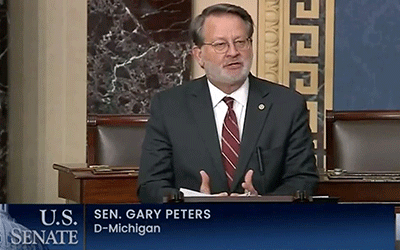
AG & FTC Sue Amazon for Illegally Maintaining Monopoly Power
|
|
|
|
|

|
|
|
|
|

● The Oakland County Board of Commissioners gave unanimous approval for County Executive Dave Coulter’s budget which makes significant investments in services for Oakland County residents.
Pontiac, Michigan – The Oakland County Board of Commissioners today approved County Executive Dave Coulter’s balanced, transparent, and fiscally-responsible budget for fiscal years 2024-2026 in a unanimous vote.
“This bipartisan, unanimous budget is proof we can accomplish great things together on behalf of our residents,” Coulter said. “It provides quality services to our residents in an efficient, responsible and equitable manner. And it builds on the programs and services that will allow us to maintain our AAA bond rating that will be so important for our future plans.”
The budget makes significant investments in initiatives and services that help residents and businesses thrive in a welcoming county such as expanding economic development programs that help small businesses grow, sustainability initiatives, and public health clinics and outreach programs that keep residents healthy. County parks and public transportation are among the areas also receiving significant support to boost the quality of life for residents and enable them to get to jobs.
Another highlight of the budget includes a three percent general salary increase for employees with the goal of attracting and retaining a talented and diverse workforce.
Oakland County’s budget is structurally balanced with no use of the budget surplus for ongoing operations and maintains a fund balance level of well above 30 percent of the county’s general fund, both of which are key practices for maintaining the county’s AAA bond rating. The general fund budgets for fiscal years 2024-2026 are $539.8 million, $547.4 million, and $560.9 million, respectively. The total recommended budgets for all funds for fiscal years 2024-2026 are $1.080 billion, $1.088 billion, and $1.108 billion, respectively.
To view the balanced budget, go to www.oakgov.com/fiscal.

Ferndale, Mich. – Little Amal, the 12-foot-tall puppet of a 10-year-old Syrian refugee girl who is trekking an epic 6,000 miles across the United States from Boston to San Diego, will appear at the Funky Ferndale Art Fair on 9 Mile west of Woodward on Sunday, Sept. 24. She will arrive by classic car parade that begins at Ferndale High School at 3:30 p.m.
Amal, whose name means “hope” in Arabic, is sharing her message of hope as she traverses the country from Sept. 7-Nov. 5. Along the way, she will join more than 1,500 artists and participate in 100-plus local events in 40 towns and cities, including Metropolitan Detroit with stops in Ann Arbor, Detroit, Ferndale, Dearborn, and Flint.
“Little Amal is a powerful symbol of the plight of refugees around the world and we’re honored that she will spend a few days in Michigan to shine a light on the need for understanding, compassion and resources for displaced people,” said Oakland County Executive Dave Coulter. “Oakland County is a welcoming county for all people, including immigrants, refugees, displaced people and Little Amal.”
From 3:30-5 p.m. Sunday, Amal will be participating in a vintage car parade through Ferndale which will drop her off at the Funky Ferndale Art Fair, where she will walk among the shoppers and artisans and receive a gift before heading toward the parking lot of Ferndale Foods where the car parade participants will be on display in a mini car show. Viewers can follow Amal in Ferndale on County Executive Office social media (@oakgov.EO).
Amal walks for the hundreds of thousands of refugees and displaced people of all ages roaming the world in search of safety. She has journeyed across 15 countries, meeting more than one million people and engaging tens of millions of followers online. She will visit Ann Arbor, Detroit, Ferndale, and Dearborn and Flint on Sept. 23, 24, 26, and 27. Then she heads to Chicago.
For more information, go to oakgov.info/WelcomingWeek or WalkWithAmal.org.

|
|
|||||||
 |
|||||||
News Release |
|||||||
|

September 19, 2023
Contact: [email protected]
Gov. Whitmer Signs Bipartisan Legislation to Protect Children, Keep People Safe
LANSING, Mich. – Governor Gretchen Whitmer signed legislation to protect minors in Michigan by preventing child marriage, building on previous legislation she signed earlier this year. The bills raise the minimum age of consent for marriage to 18 and updates laws to effectively implement the child marriage ban.
“Keeping Michiganders safe and healthy is one of my top priorities, and today’s bipartisan bills will build on our efforts to protect young people—especially young women—from abuse,” said Governor Whitmer. “As a county prosecutor, I went after those who used their power to prey on young people, and as governor, I am proud to sign legislation to strengthen protections for children and survivors into law. Together, we can make Michigan a safe, welcoming state where you can grow up and pursue your potential.”
House Bill 4294, sponsored by Rep. Kara Hope, D – Lansing, establishes 18 as the minimum age of consent for marriage.
House Bill 4295, sponsored by Rep. Alabas Farhat, D – Dearborn, prohibits secret child marriages, which are done when a marriage record is sealed to the public.
“It’s time for us to ban the cruel practice of child marriage,” said state Representative Alabas Farhat (D-Dearborn), sponsor for HB 4295. Abusive adults take advantage of minor children, setting them up for a life of torment. It is our duty to protect the children of Michigan, and I’m grateful this legislation is being signed into law.”
House Bill 4296, sponsored by Rep. Betsy Coffia, D – Traverse City, is a grandfather law that ensures minors who are currently married do not lose their spousal benefits under the new laws.
“There are many aspects of our society that we restrict to legal adults — voting, signing contracts and more. It’s well past time for marriage to join that list,” said state Representative Betsy Coffia (D-Traverse City), sponsor of HB 4296. “Not only is this action the right thing to do to protect children from predators, it’s just common sense.”
The governor intends to sign the final bill in this package, House Bill 4302, upon presentation. House Bill 4302, sponsored by Rep. Joey Andrews, D – St. Joseph, modifies references to married minors in the Michigan penal code.
“As a new father, I share in the worries of every parent, the foremost of which is making sure my daughter is safe and healthy. Banning child marriage is an overdue step in that direction,” said state Representative Joey Andrews (D-St. Joseph), sponsor of HB 4302. “Child marriage is the domain of sexual predators and their enablers, and I’m proud to be part of erasing it from Michigan statute.”
The governor also signed legislation expanding use of ignition interlock devices, helping keep people safe on the road.
Together, Senate Bills 134 and 135 expand the current Driving While Intoxicated/Sobriety Court Interlock Program into the Specialty Court Interlock Program. The expanded program would include specialty courts in addition to DWI/sobriety courts and allow eligible participants to have a vehicle equipped with an ignition interlock device in order to obtain a restricted driver license. An ignition interlock device measures a driver’s alcohol concentration before the vehicle can be started.
“Specialty treatment courts are a unique facet of our justice system that help offer a path to true restoration,” said state Senator Kevin Hertel. “By marrying treatment for underlying concerns with supervised rehabilitation, these courts offer reduced recidivism and increased community support. I am grateful to my legislative colleagues and the governor for their help in expanding these vital programs.”
Senate Bill 134 was sponsored by state Senator Ruth Johnson, R – Holly and Senate Bill 135 was sponsored by state Senator Kevin Hertel, D – St. Clair Shores.

|
|||
|